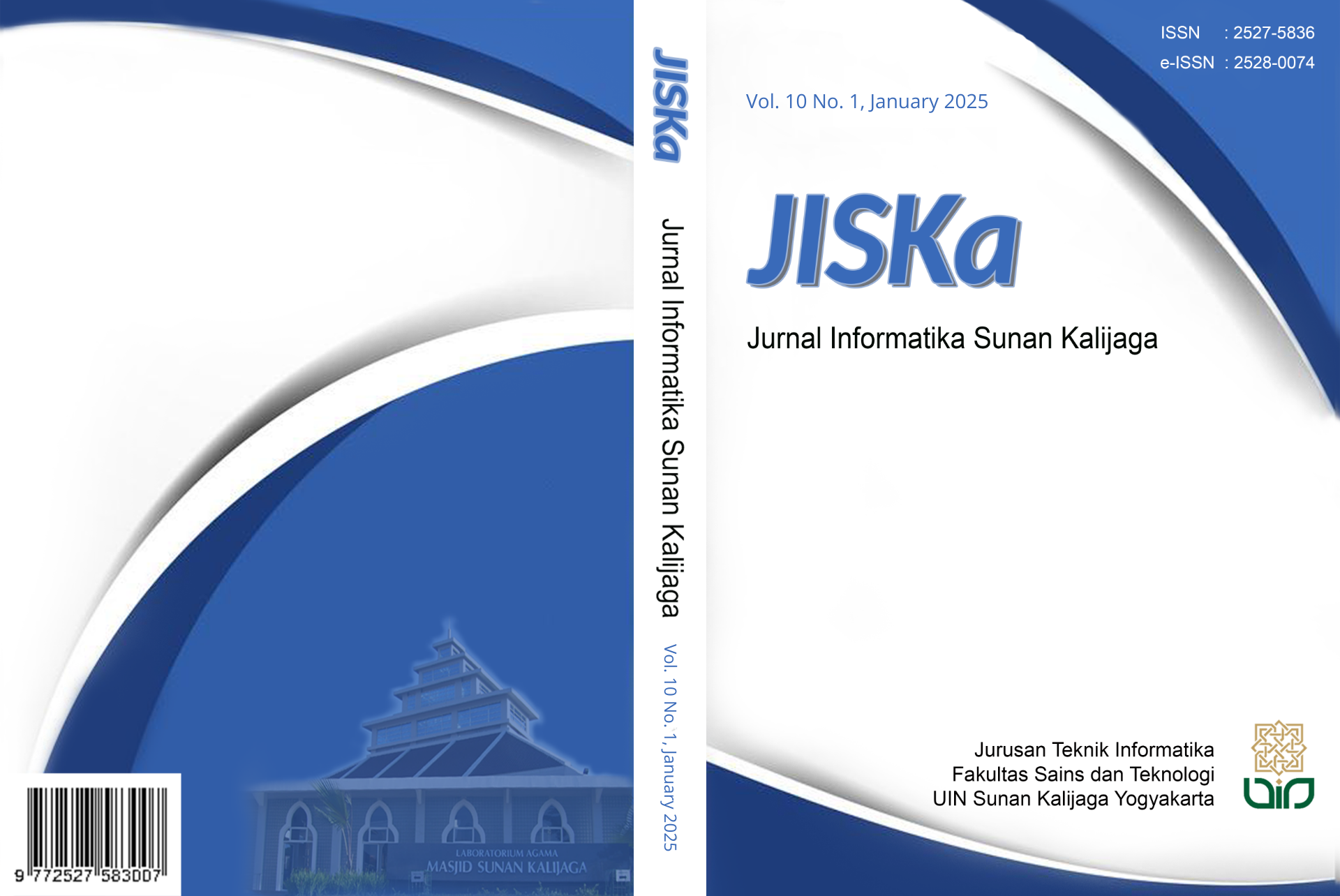Performance Evaluation of Long Short-Term Memory for Chili Price Prediction
DOI:
https://doi.org/10.14421/jiska.2025.10.1.33-47Keywords:
LSTM, Prediction, RMSE, Chili Prices, GroceriesAbstract
Grocery prices often experience fluctuations in several regions of Indonesia, such as East Java Province. One of the commodities affected is chili, including both red chilies and bird’s eye chilies. Predictive steps that utilise machine learning, such as Long Short-Term Memory (LSTM), can be taken to estimate the next price of chili, with the expectation that the authorities can implement the appropriate strategy. LSTM is a network that was developed from RNN networks in previous times by offering a longer cell memory, allowing for the storage of more information. This research focuses on determining whether the LSTM network can be applied to the task of chili price prediction and identifying the suitable architecture and hyperparameter configuration for this case. For this reason, the experimental method is employed by testing several predetermined variables to determine the optimal architecture and hyperparameter configuration. The results of this research demonstrate that the LSTM network can be effectively applied in this case, and the obtained architecture and optimal hyperparameter configuration are consistent for both types of chilies, namely red chilies and bird’s eye chilies. For red chili, the best RMSE value that can be produced is 1751.890 and 1888.741 for bird’s eye chili.
References
Adinugroho, R. (2023). Perbandingan Rasio Split Data Training dan Data Testing Menggunakan Metode LSTM Dalam Memprediksi Harga Indeks Saham Asia [UIN Syarif Hidayatullah Jakarta]. https://repository.uinjkt.ac.id/dspace/handle/123456789/67314
Amendolara, A. B., Sant, D., Rotstein, H. G., & Fortune, E. (2023). LSTM-Based Recurrent Neural Network Provides Effective Short Term Flu Forecasting. BMC Public Health, 23(1), 1788. https://doi.org/10.1186/s12889-023-16720-6
Arfan, A., & ETP, L. (2020). Perbandingan Algoritma Long Short-Term Memory dengan SVR pada Prediksi Harga Saham di Indonesia. PETIR, 13(1), 33–43. https://doi.org/10.33322/petir.v13i1.858
Chairurrachman, I. (2022). Penerapan Long Short-Term Memory pada Data Time Series untuk Prediksi Harga Saham PT. Indofood CBP Sukses Makmur Tbk (ICBP) [UIN Sunan Kalijaga Yogyakarta]. https://digilib.uin-suka.ac.id/id/eprint/53738/
Deepa, B., & Ramesh, K. (2022). Epileptic Seizure Detection Using Deep Learning Through Min Max Scaler Normalization. International Journal of Health Sciences, 6, 10981–10996. https://doi.org/10.53730/ijhs.v6nS1.7801
Dubey, S. R., Singh, S. K., & Chaudhuri, B. B. (2022). Activation Functions in Deep Learning: A Comprehensive Survey and Benchmark. Neurocomputing, 503, 92–108. https://doi.org/10.1016/j.neucom.2022.06.111
Gustineli, M. (2022). A Survey on Recently Proposed Activation Functions for Deep Learning. Engineering Archive (Engrvix). https://doi.org/10.31224/2245
Hochreiter, S., & Schmidhuber, J. (1997). Long Short-Term Memory. Neural Computation, 9(8), 1735–1780. https://doi.org/10.1162/neco.1997.9.8.1735
Irfan, D., Gunawan, T. S., & Wanayumini, W. (2023). Comparison of SGD, Rmsprop, and Adam Optimation in Animal Classification Using CNNs. International Conference on Information Science and Technology Innovation (ICoSTEC), 2(1), 45–51. https://doi.org/10.35842/icostec.v2i1.35
Sunny, Md. A. I., Maswood, M. M. S., & Alharbi, A. G. (2020). Deep Learning-Based Stock Price Prediction Using LSTM and Bi-Directional LSTM Model. 2020 2nd Novel Intelligent and Leading Emerging Sciences Conference (NILES), 87–92. https://doi.org/10.1109/NILES50944.2020.9257950
Joseph, F. J. J., Nonsiri, S., & Monsakul, A. (2021). Keras and TensorFlow: A Hands-On Experience. In Advanced Deep Learning for Engineers and Scientists (pp. 85–111). Springer International Publishing. https://doi.org/10.1007/978-3-030-66519-7_4
Li, W., Kiaghadi, A., & Dawson, C. (2021). Exploring the Best Sequence LSTM Modeling Architecture for Flood Prediction. Neural Computing and Applications, 33(11), 5571–5580. https://doi.org/10.1007/s00521-020-05334-3
Moghar, A., & Hamiche, M. (2020). Stock Market Prediction Using LSTM Recurrent Neural Network. Procedia Computer Science, 170, 1168–1173. https://doi.org/10.1016/j.procs.2020.03.049
López, O. A. M., López, A. M., & Crossa, J. (2022). Overfitting, Model Tuning, and Evaluation of Prediction Performance. In Multivariate Statistical Machine Learning Methods for Genomic Prediction (pp. 109–139). Springer International Publishing. https://doi.org/10.1007/978-3-030-89010-0_4
Qiu, J., Wang, B., & Zhou, C. (2020). Forecasting Stock Prices with Long-Short Term Memory Neural Network Based on Attention Mechanism. PLOS ONE, 15(1), e0227222. https://doi.org/10.1371/journal.pone.0227222
Rahmadini, R., LorencisLubis, E. E., Priansyah, A., N, Y. R. W., & Meutia, T. (2023). Penerapan Data Mining untuk Memprediksi Harga Bahan Pangan di Indonesia Menggunakan Algoritma K-Nearest Neighbor. Jurnal Mahasiswa Akuntansi Samudra, 4(4), 223–235. https://doi.org/10.33059/jmas.v4i4.7074
Riyantoko, P. A., Fahruddin, T. M., Hindrayani, K. M., & Safitri, E. M. (2020). Analisis Prediksi Harga Saham Sektor Perbankan Menggunakan Algoritma Long-Short Terms Memory (LSTM). Seminar Nasional Informatika (SEMNASIF), 1(1), 427–435. http://www.jurnal.upnyk.ac.id/index.php/semnasif/article/view/4135
Suradiradja, K. H. (2022). Algoritme Machine Learning Multi-Layer Perceptron dan Recurrent Neural Network untuk Prediksi Harga Cabai Merah Besar di Kota Tangerang. Faktor Exacta, 14(4), 194. https://doi.org/10.30998/faktorexacta.v14i4.10376
Syaidah, K., Chrisnanto, Y. H., & Abdillah, G. (2020). Prediksi Harga Sembako di DKI Jakarta Menggunakan Artificial Neural Network. JUMANJI (Jurnal Masyarakat Informatika Unjani), 3(02), 136. https://doi.org/10.26874/jumanji.v3i02.63
Yadav, A., Jha, C. K., & Sharan, A. (2020). Optimizing LSTM for Time Series Prediction in Indian Stock Market. Procedia Computer Science, 167, 2091–2100. https://doi.org/10.1016/j.procs.2020.03.257
Yanwardhana, E. (2022, June 15). Ternyata Gegara Ini Harga Cabai Terbang Sampai Ratusan Ribu. CNBC Indonesia. https://www.cnbcindonesia.com/news/20220615103728-4-347195/ternyata-gegara-ini-harga-cabai-terbang-sampai-ratusan-ribu
Downloads
Published
How to Cite
Issue
Section
License
Copyright (c) 2025 Fata Nabil Fikri, Nurochman

This work is licensed under a Creative Commons Attribution-NonCommercial 4.0 International License.
Authors who publish with this journal agree to the following terms as stated in http://creativecommons.org/licenses/by-nc/4.0
a. Authors retain copyright and grant the journal right of first publication with the work simultaneously licensed under a Creative Commons Attribution License that allows others to share the work with an acknowledgement of the work's authorship and initial publication in this journal.
b. Authors are able to enter into separate, additional contractual arrangements for the non-exclusive distribution of the journal's published version of the work (e.g., post it to an institutional repository or publish it in a book), with an acknowledgement of its initial publication in this journal.
c. Authors are permitted and encouraged to post their work online (e.g., in institutional repositories or on their website) prior to and during the submission process, as it can lead to productive exchanges, as well as earlier and greater citation of published work.










